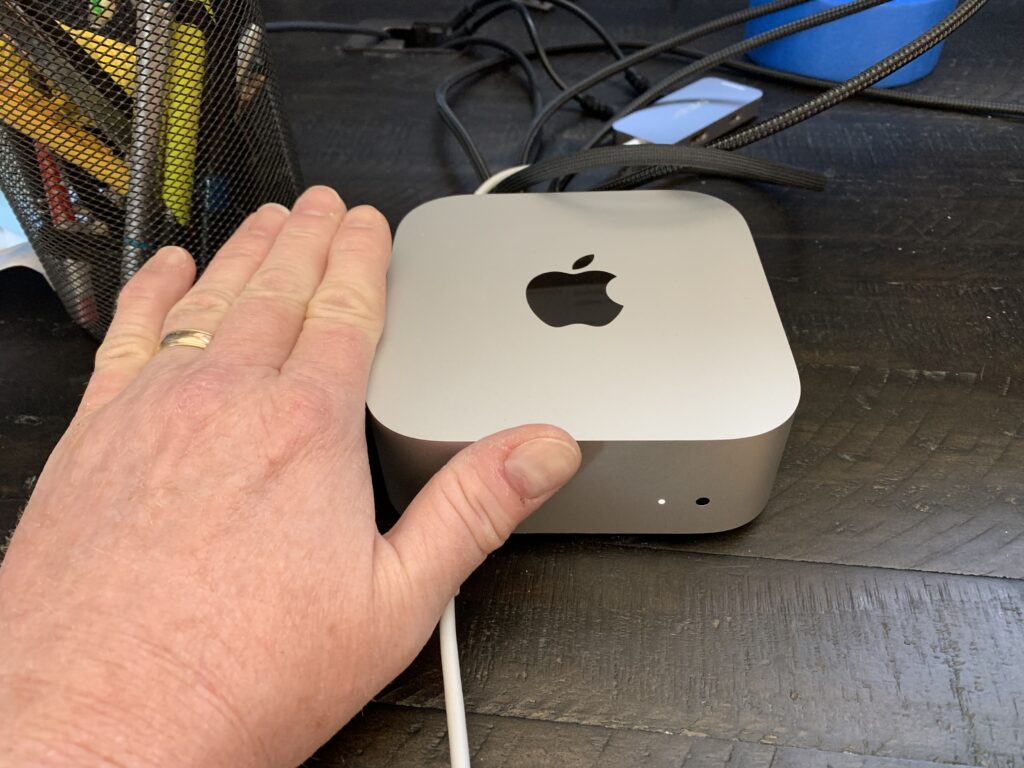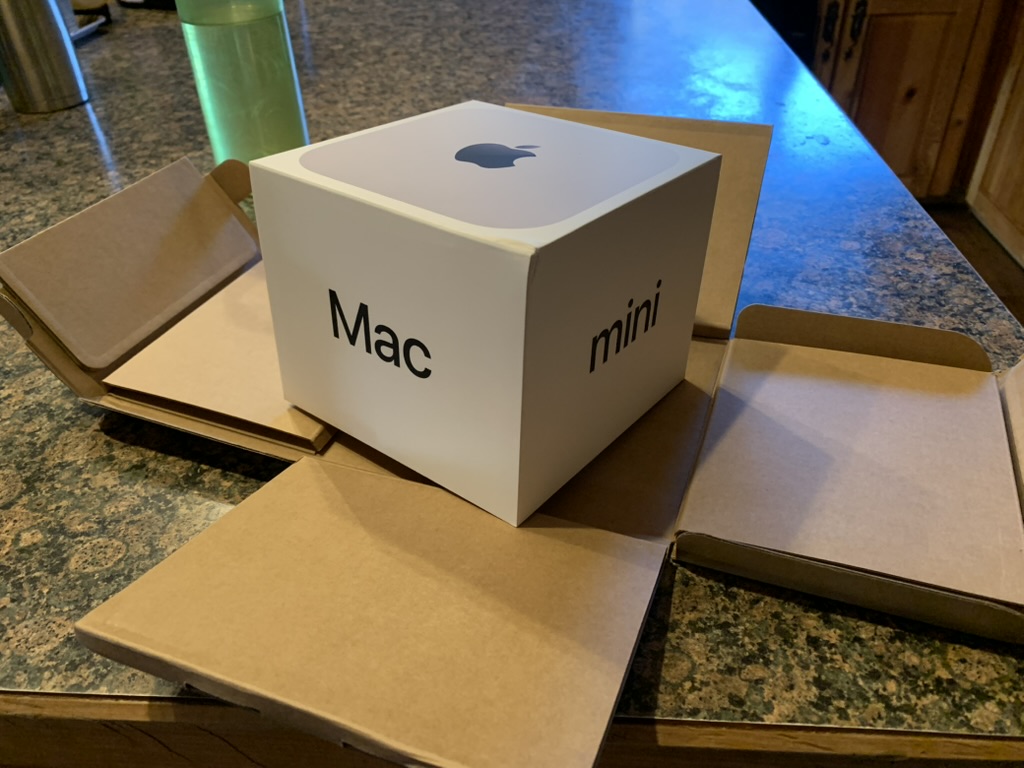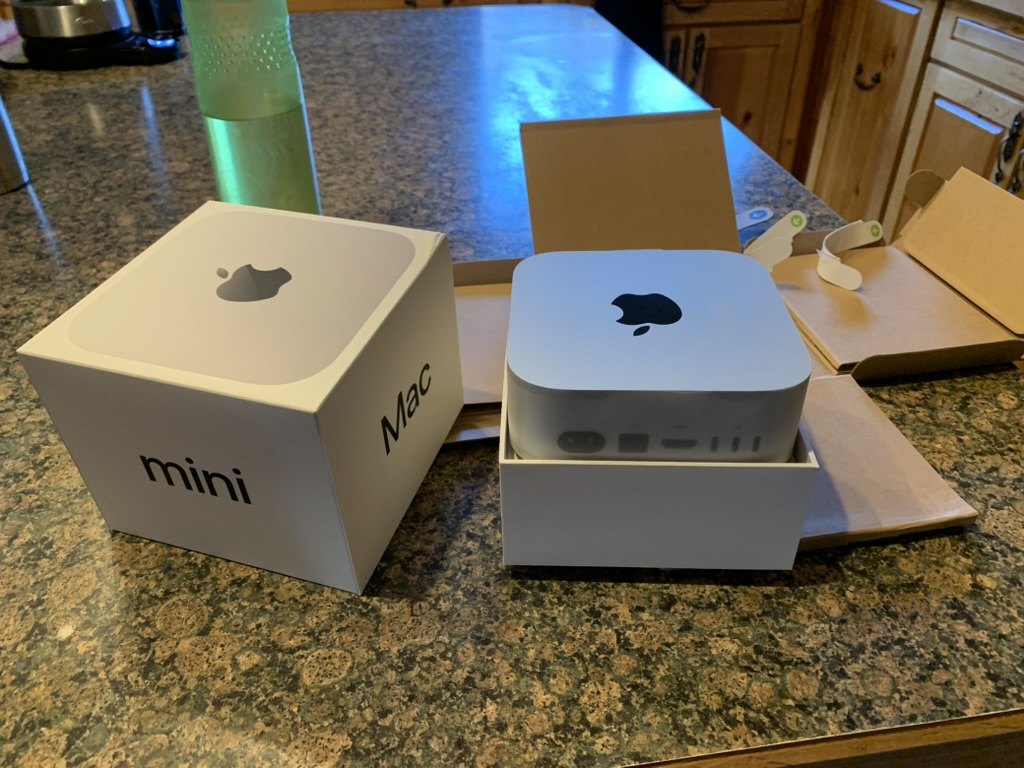My new Mac Mini arrived earlier this week as I had hoped and has been set up in my somewhat re-organized office. I’ve had a bit of time to play with the new computer and have a few observations to make.
The Mini is mini
I was aware that the Mini had been reduced in size, but it is quite tiny: around the size of the smallest NUC devices, or about 12.7 by 12.7 cm (5″ x 5″).

The machine is small enough to comfortably hide on the back of a monitor if that was your desire. My plan is just keep it on my desk as it is tiny enough to not be an impediment there.
As is usual for Apple products, unpacking the little guy was actually a pleasure: the boxes, even the outer shipping box, are all ‘engineered’ in a very satisfying way. A small thing, indeed: but experiencing neat, tidy packaging with a minimum of waste was remarkable after unpacking a couple of monitors that produced more garbage than fifty Mac Minis, most of it not recyclable.



Ports… never enough
One of the nice things about the more recent ‘M’ (M2 Pro and M4) processor Mac Minis is that they support up to three displays. Note that the resolution of the displays supported on the M4 is ‘limited’: up to two 6K and one 5K display on the standard M4 (or three 4K displays), or three 6K displays on the M4 Pro.
Displays are handled through three Thunderbolt 5 (USB-C type) connectors (plus an HDMI connector if you are so inclined) on the back of the machine. There is also a physical Ethernet port supporting 10 Gbps on the back. There are also two USB-C (not Thunderbolt) connectors on the front.
My displays are two identical LG 27″ UHD 4K displays (LG 27UP850N-W) with USB-C interfaces. They are quite nice in my opinion and were far cheaper at around CDN$550 each versus the OLED or quantum dot reference standard displays I considered that run more like $1,500 a piece. And if you are shopping for actual 6K displays you had better have very deep pockets: the Apple Pro Display XDR is over $7,400; the Dell UltraSharp U3224KB is around $3,500. Buying two of either of those would be financially imprudent for me.
Even with the Mini’s collection of different ports I am still having to attach various USB ‘hubs’ to my Mini. This is mostly due to the USB-A ports several of my older devices consume, notably my Steelseries Apex TKL mechanical keyboard which requires two USB-A connections. My plan is to add a matched ‘dock’ under the Mac Mini later to eliminate the excess wiring mess the hubs cause.
Performance
My Mini is equipped with 32 GB of RAM and 1 TB of storage. I opted for the M4 Mac Mini instead of the M4 Pro. The Pro is about $600 more expensive: on a device that sells for about CDN$1,800 as I equipped it, $600 is a significant uplift. And I honestly don’t think I need the ‘Pro’ level performance at this time.
So how does the Mac Mini M4 stack up performance-wise versus my older Macs? I used Geekbench 6 to run some tests. As I understand it, Geekbench scores are an aggregate across quite a large selection of different testing methods to calculate a score, but I make no claims as to the suitability of the results. In any case, here is what I got:
| Model | CPU | GPU (OpenCL) |
|---|---|---|
| Mac Mini M4 (2024; 10 cores) | 3832 single core; 14850 multi | 37788 |
| MacBook Pro i9 Intel (mid 2019; 8 cores) | 1575 single core; 6649 multi | 6096 |
| MacBook Air i5 Intel (2020; 4 cores) | 1257 single core; 3241 multi | 5561 |
So the Mac Mini M4 is easily twice as fast as either of the Intel MacBooks I have at hand. That is pretty much what I was hoping for. The GPU performance for the M4 is even more impressive. I don’t typically play games on my Mac, but I imagine that extra ability to push pixels will come in handy.
More practically, the Mini feels more ‘effortlessly fast’ to use than my main ‘go to’ computer, the MacBook Air. I have not been doing any video rendering jobs or the like lately. I had set aside that kind of activity for the past few years as I found it was tedious back when I was using my MacBook Pro for the task. I expect that the Mini will perform such CPU-dependent tasks with less pain. I might finally edit and encode a few of the videos I took on motorcycle rides a decade or so ago.
Irritants
I have no complaints at all about the Mac Mini itself. I do, however, have a complaint about Apple’s ‘Touch ID’ technology. I like keeping my computers secure with a good password, but typing such a password out every time I use the machine is not fun. On my MacBooks this first world problem is easily resolved: they incorporate Touch ID on the built-in keyboard.
The Mini does not come with a keyboard. The choice is to either buy Apple’s ‘Magic’ keyboard, the most expensive of which includes Touch ID support, or to buy a suitable third party keyboard. I like full-action keyboards as opposed to the Magic ‘flat’ style, but this introduces a problem: no third party keyboard supports Touch ID.
There is a good reason for this: Apple has a robust security mechanism that manages the interaction between the fingerprint scanner on the keyboard and the computer. This is not something they expose or sell to third parties. I get that.
But why not add Touch ID to one of Apple’s own Trackpads? I have no quibble about using Apple’s trackpads, it is just the keyboard feel that I have strong preferences around. There are people who have bought entire Magic keyboards, stripped out the Touch ID scanner and security components, and Frankensteined their own trackpad + Touch ID configurations to solve this exact complaint. Kudos to them, but what a waste of a keyboard! Come on, Tim Cook– a Touch ID equipped trackpad seems like an obvious product to release.

Pingback: Fresh Air… – Ubergeek Kelly's World- Life, technology, science, rants